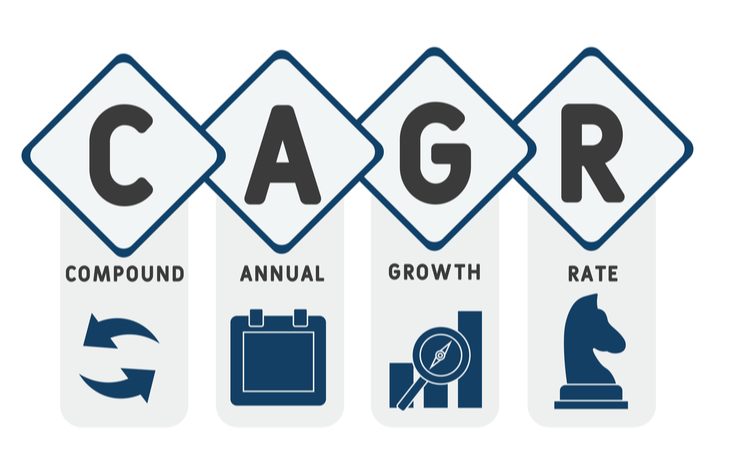What is the Compound Annual Growth Rate (CAGR)?

Everyone wants some idea of what to expect from their investment before they open a position. And while there’s no way to tell for certain how an investment will perform, there are ways to assess the recent growth trends of a company. When looking at prior performance, many investors and analysts use compound annual growth rate (CAGR) as a way to understand how a company has performed over a given time period.
CAGR can also tell investors how a company might grow in the future. For instance, you might extrapolate the most recent three-year growth rate of a company as a means for predicting how it’ll perform over the next three years. CAGR establishes quantifiable data about the proven performance of a company that sets expectations.
Here’s a closer look at CAGR as a metric: how to calculate it, what it means and some of the context it can provide when applied correctly to asset evaluation.

Compound Annual Growth Rate Formula
To calculate CAGR, you need access to historical revenue data for a company. While the time period can vary, the data needs to be sequential and calculated the same way. Here’s the formula for CAGR:
CAGR = (End Value/Beginning Value)1/n – 1 × 100
In this formula, n represents the number of years used to calculate the growth rate. Many analysts will use three to five, for recency and relevance. However, when calculating CAGR for broader analysis, such as the trend of an entire industry or sector, it’s not uncommon to use 10-year data.
An Example of Compound Annual Growth Rate
So long as there’s historical data available, investors can calculate a forward-looking estimate of growth. Using the formula from above, let’s look at the CAGR of a fictional company. Here’s the five-year trailing revenue data for ABC Company, which has seen some ups and downs:
- In Year 1: $5 million
- By Year 2: $12 million
- In Year 3: $9 million
- In Year 4: $15 million
- And in Year 5 (current): $10 million
To calculate the CAGR, divide 10 (ending value) by 5 (beginning value), raised to an exponent of ¼ (years). The resulting value is 18.92%, which signifies the growth rate for ABC Company over the past four years. CAGR is always expressed in a percentage.
How to Use CAGR as an Evaluative Metric
Once you have the CAGR of a company, you can use it as a comparison metric against other companies. For instance, you might be trying to decide between two companies: a fintech startup and a consumer electronics company. It’s difficult to compare them side by side because they’re fundamentally different. Using CAGR to look at the previous three years can shed light on how they’re performing. You might find that the CAGR of the fintech is 24%, while the CAGR of the electronics company is only 16%.
It’s also possible to use CAGR to compare investment vehicles. For example, you might be torn between an ETF and a closed-end mutual fund. Looking at the five-year trailing performance of both, it’s possible to use CAGR as an evaluative metric. The ETF might have a CAGR of 8%, while the mutual fund has a CAGR of 9%. The difference is small, but it’s worth knowing before you choose to invest.
It’s important to remember that CAGR can measure virtually any quantifiable metric, so long as there’s historical data. Revenue is the most popular metric, but you can also measure the CAGR of a company’s spending, its customer growth rates, dividend growth and more.
Using CAGR as an Investment Planning Tool
Beyond evaluating investments, CAGR is also a practical tool for investment planning. By extrapolating growth rate data over a future period of time, investors can determine how well they need an investment to perform or use CAGR to set realistic investment goals.
Say, for example, you want to create an investment nest egg for your dream house. You need to reach $750,000 in the next 20 years. You have $50,000 to invest today. According to the CAGR formula, the required rate of return needed to meet your goal is 14.5%. This sets the standard for long-term portfolio performance.
Drawbacks of Using CAGR as a Metric
It’s important to recognize the limitations of CAGR as a forward-looking metric. While it uses historical data, the past isn’t indicative of the future. This is further evidenced by the fact that CAGR smooths-out the volatility within the time period measured. A company might have a healthy CAGR over a five-year period, but erratic up-and-down earnings from year to year. Because of this, it’s difficult to gauge company health without further investigation into other financial trends.
CAGR is also subject to manipulation. Shortening or lengthening the period used to calculate growth rate can include or omit years that significantly impact the CAGR total. This is also true when it comes to calculating CAGR of held assets. If you buy a stock at the end of the year, factoring that year into CAGR doesn’t make sense since you didn’t hold the asset for the majority of that period. Deciding what to include or omit can be a tedious process.
Compound Annual Growth Rate is a Useful Metric
Compound annual growth rate is a very important metric for qualifying past performance of an investment and comparing it to others. And while it has its shortcomings, it provides a simple way to quantify a trend. Investors can (and should) use CAGR to evaluate potential investments and the performance of their portfolio, as well as use it as a planning tool to set realistic goals for the future.






